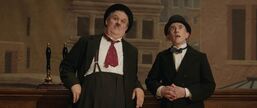The interpretation is not careless. It reproduces the simple roughness of early Hollywood comedy performances. The audience's laughter is surprisingly low, and the slightly weird body and language can easily win the roar of laughter.
In the 1930s, modern comedy entered a mature stage from its embryonic stage. In terms of art form, Stan and Ollie’s creativity and performance remained at the stage of "comic", as long as you need it, you can be funny anytime and anywhere. There is no need for the situation, and it is not specific. The humor that relies on deep associations in the context is still far away. This is the slick side of life.
This film is the process of putting "funny" on the "movie" and "stage". Shanghai comics have been enduring for a long time and have survived to this day, but the means of making laughs belong only to the age (despite continuous innovation).
The problem is not with Stan and Ollie, two comedians who belong only to the era, but with the desire to worship history but lack of innovation when recreating outdated tastes. This kind of biographies is far inferior to the depiction of Chaplin in the same era, that kind of contemplation between artistic life and real life.
View more about Stan & Ollie reviews











